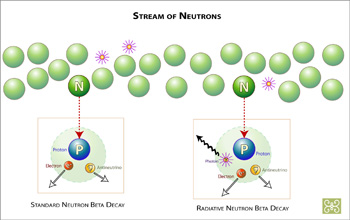Multimedia Gallery
Three out of every 1,000 neutron decays produce photons of light.
To observe radiative decay photons, the researchers carefully measured when the decay products in a beam of neutrons--that is, protons, electrons, antineutrinos, and sometimes photons--arrived at a detector. If radiative decay occurs, according to theory, photons and electrons will arrive 20-millionths of a second sooner than the slower protons. Antineutrinos are too weak to be detected.
Credit: Zina Deretsky, National Science Foundation
Images credited to the National Science Foundation, a federal agency, are in the public domain. The images were created by employees of the United States Government as part of their official duties or prepared by contractors as "works for hire" for NSF. You may freely use NSF-credited images and, at your discretion, credit NSF with a "Courtesy: National Science Foundation" notation.
Additional information about general usage can be found in Conditions.
Also Available:
Download the high-resolution JPG version of the image. (304 KB)
Use your mouse to right-click (Mac users may need to Ctrl-click) the link above and choose the option that will save the file or target to your computer.
Related story: Researchers Observe Rare Light-emitting Decay of Neutrons



